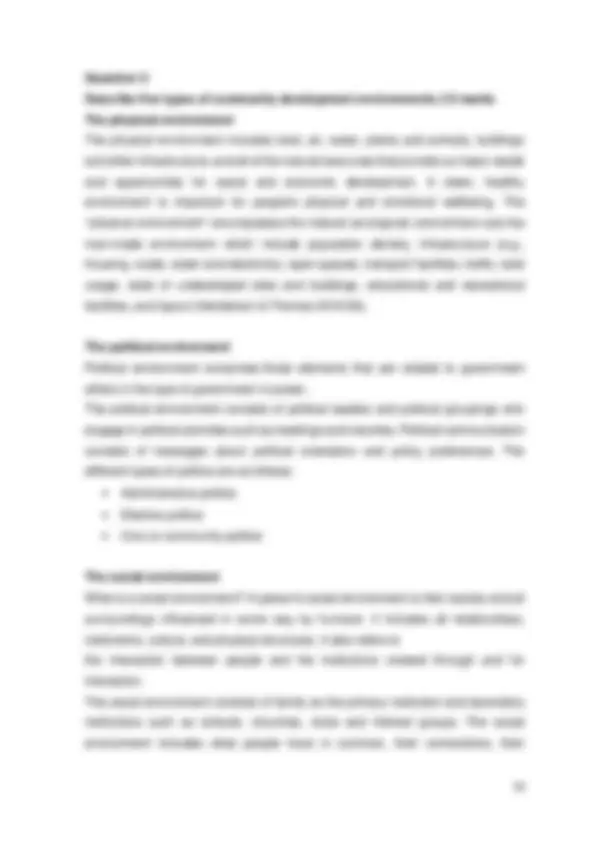












Study with the several resources on Docsity

Earn points by helping other students or get them with a premium plan


Prepare for your exams
Study with the several resources on Docsity

Earn points to download
Earn points by helping other students or get them with a premium plan
Community
Ask the community for help and clear up your study doubts
Discover the best universities in your country according to Docsity users
Free resources
Download our free guides on studying techniques, anxiety management strategies, and thesis advice from Docsity tutors
BSW3703_Assignment_01-Community work, Theories, approaches and methods. 2023 UNISA
Typology: Assignments
1 / 18

This page cannot be seen from the preview
Don't miss anything!











Question 1 Discuss community work as an intervention method in social work service delivery (10 marks) Community work as an intervention method in social work service delivery can solve the problems of many people in the community through their collective involvement. Community work is one of the three intervention methods of social work and it is one of the five interrelated methods in social work and takes place at the macro level. Community work falls under indirect practice and involves working in and with communities and political institutions. Community work can take place in an organisation, a neighbourhood, a community or society as a whole. Self-help groups and community-based social action that address problems/needs or impediments like a lack of services and facilities and that are aimed at yielding benefits such as a more caring society and a better quality of life, are types of intervention that can be used. Processes and skills that may be required to bring about the necessary changes in the person-in-environment domain are being referred to as social work methods. Community work is interrelated with those social work methods (i.e., casework and group work) and addresses impediments to social functioning. Casework and group work skills are utilised in community work. Community work is also related to group work in that different types of groups are used in community work. Question 2 Describe the concept community the four different types of communities. ( marks) A common definition of community emerged as a group of people with diverse characteristics who are linked by social ties, share common perspectives, and engage in joint action in geographical locations or settings. Being part of an engaging community gives us a sense of belonging. It enables us to share personal relatedness and support perpetual growth of each other, ourselves and our environment.
Geographic communities A geographic community is area based, meaning a community that is closely spatially located, for example a town, a village, a particular street or neighbourhood. A community may have physical boundaries created by, for example, a river or a street that make it distinct or separate. Within a geographic community, you will find both communities of identity and communities of interest. Even if there is some sense of community, the members of a community are still unique individuals with their own, unique experiences. Communities of identity Community identity is based on birth and belonging rather than on some form of acquired qualifications or accomplishment. Communities of identity refer to the shared definition of a group, derived from members' common interests and shared experiences. It also refers to common, identifiable characteristics or attributes such as a common culture (including language, music, religion or customs). Identity can be based on age, gender or sexuality. the group shares and identifies with a cultural-symbolic dimension, including a purpose, an interest, work or an identity. A community of identity may or may not be geographically bound. Communities of interest A community of interest is a group or community of people who share a common interest or passion. These people exchange ideas and thoughts about the given passion, but may know (or care) little about each other outside this area. In other words, "a community of interest is a gathering of people assembled around a topic of common interest. Communities of interest include social movements such as women’s rights movements, political parties, peace movements, environmental movements or public education campaigns. Individuals become a part of the community voluntarily. Examples are household groups, kinship groups, friendship/peer groups and self- help groups. Intentional communities Intentional Community includes ecovillages, cohousing, residential land trusts, communes, co-ops, and housing cooperatives. An “intentional community” is a
these strengths and resources in an organised way to address agreed-upon needs and priorities in a way that works for the community. ABCD focuses primarily on social assets such as individual assets (gifts, skills, talents and capacities of all citizens). The quality of relationships among individuals, families, groups and associations (churches, clubs, cultural groups, neighbourhood groups) and networks. ABCD also focuses on resources of formal institutions (e.g., businesses, schools, libraries, community colleges, hospitals, parks and social service agencies). Cunningham and Mathie mention five types of maps: associations, individual gifts, skills and capacities, assets of local institutions, physical assets and natural resources, and the local economy. The ABCD approach building block is the recognition of social capacity of the community. It is a people centred participatory approach to development based on the principles of empowerment and ownership. ABCD approach assumes that community development uses internal strengths and assets and encourages positive action for change. The basic premise of Asset Based Community Development Model perception of the community is that all communities, no matter how poor possess strengths, assets and energies that can contribute tremendously to self-sustained improved quality of life. The ABCD approach points out that communities need not only be viewed as a social and geographical place where change can take place, but the people’s understanding of their situation in itself can serve as a considerable strength in the change process. The primary assets of the community are the social aspects. Communities are built on assets. Communities become more capable as they are increasingly able to apply their strengths and assets to improve the overall wellbeing of the community (Schenck et al.2010: 6-7). Question 4 Describe five community practice models (15 marks) Community development model Community development is based on the developmental approach (Weyers 2011:153–155). It is a planned partnership between external organisations (government, non-profit organisations, etc.) and local people. It is based on the
perception that the community members are in the best position to develop themselves and their own communities and to eliminate the challenges that obstruct this process. The community development model is based on working with groups and individuals to help them acquire skills and confidence to improve the quality of the lives of its members and communities. Development should be community driven and owned process. The ultimate goal is to empower the community with appropriate attitudes and behaviour patterns. Social planning model The social planning model is a process that assists communities in identifying its strengths and weaknesses and also to finding opportunities that they can utilise to improve the quality of life in their community according to Weyers 2011:219. It focuses establishing new services where these are lacking as well on the perception that any community member can be affected by social problems and that they need some kind of intervention, for instance, therapeutic services from professionals to deal with social ills. The purpose of the social is to improve the quality of existing services or facilitates the community’s access to services in three ways: by establishing new services where these are lacking by improving the quality of existing services or by the community’s access to services. Social action Social action is described as the deliberate effort that aims at achieving the institutional change to: Meet a need Solve a social problem Correct an injustice or Enhance the quality of human life. The basic aim of social action is to address the socio-political barriers, inequities and injustices that exist in a community or society so that it would contribute more fully to the common good of all citizens. It has a power focus and aims on structural change. The social action model is a reaction to the more paternalistic forms of community work and also a response by relatively powerless groups to increase
Question 5 Describe five types of community development environments (15 marks The physical environment The physical environment includes land, air, water, plants and animals, buildings and other infrastructure, and all of the natural resources that provide our basic needs and opportunities for social and economic development. A clean, healthy environment is important for people's physical and emotional wellbeing. The “physical environment” encompasses the natural (ecological) environment and the man-made environment which include population density, infrastructure (e.g., housing, roads, water and electricity), open spaces, transport facilities, traffic, land usage, state of undeveloped sites and buildings, educational and recreational facilities, and layout (Henderson & Thomas 2013:56). The political environment Political environment comprises those elements that are related to government affairs in the type of government in power. The political environment consists of political leaders and political groupings who engage in political activities such as meetings and marches. Political communication consists of messages about political orientation and policy preferences. The different types of politics are as follows: Administrative politics Elective politics Civic or community politics The social environment What is a social environment? A person's social environment is their society and all surroundings influenced in some way by humans. It includes all relationships, institutions, culture, and physical structures. It also refers to the interaction between people and the institutions created through and for interaction. The social environment consists of family as the primary institution and secondary institutions such as schools, churches, clubs and interest groups. The social environment includes what people have in common, their connections, their
contacts, their communication, their relations in terms of structures, groupings and networks and their norms and values. The cultural environment Cultural environment is the behavior or beliefs of a certain group of people based on factors influencing their culture. It can also be described as norms and values that people use to understand and explain their physical and social environment According to the African tradition of ubuntu, people have a place in society and certain obligations towards society. Culture can be defined as all the ways of life including arts, beliefs and institutions of a population that are passed down from generation to generation. Culture has been called "the way of life for an entire society." The psychological environment The psychological learning environment covers the cognitive environment, which means the information and skills to be learnt, and the emotional environment, which includes emotions and motivation. People experience life in their own peculiar way (Swanepoel & De Beer 2016:23). Knowledge of the psychological environment of a community is important for developing relationships with people in that community. The term “experiential world” may be useful to explain the term “psychological environment” because the experiential world encompasses the needs, behaviour, emotions, values and perceptions about different areas of life of individuals in a community (Grobler, Schenck & Mbedzi 2013; Hope, Timmel & Hodzi 1995:56, book 3). Question 6 Describe five principles for guiding work with communities (15 marks) Swanepoel and De Beer (2016:2013) refer to principles as beliefs, guiding lights and ideals. The principles of social work are important for working with communities. According to the International Federation of Social Workers (IFSW) (2012), social workers must uphold the following principles, among others:
the obligations that the State have towards them. Social welfare services and programmes are based on respect for human rights and fundamental freedoms as articulated in the Constitution of the Republic of South Africa. Social workers understand that every person regardless of position in society has fundamental human rights such as freedom, safety, privacy, an adequate standard of living, health care, and education. Question 7 Discuss five phases of the community work process according to Only Study guide for BSW370(15 marks) Phase 1: Contact making The first phase of working with a community is also referred to as connecting and discovery (Schenck, et al 2010) or situation analysis (Weyers, 2011). Contact- making is discussed with reference to the following aspects The people must get to know and accept the community worker. The community worker must get to know and understand the people and their circumstances and context. The people and the community worker must get to a point where they can identify a need that they can address through a project. Making contact is a two-way process. The community gets to know the worker and the worker gets to know the people, their environment, and in the process the people become more aware of themselves, their needs and their resources. If a strengths- and asset-based approach is followed, the third objective is about analysing opportunities (Skhosana and Morake.2019:151-152). Phase 2: Needs and resources assessment The basic purpose of the second step is to explore and assess or analyse the previously identified issues or unfulfilled needs and unutilised potential in greater detail. Without a clear perception of a need or the perception of a need, a community work process and project cannot take place. This need or perception of a need must be heartfelt among the people who must participate in a project. Therefore, needs identification is a prerequisite for action – it is the first step that must be taken before
a project commences. In this phase a worker starts working with an action group and structures it. The worker and the action group start developing a project development, exploring and assessing needs and resources together. Four actions have to take place during needs assessment: holding the first meeting clearly identifying and formulating one issue, concern or need as a starting point for a project identifying resources forming a committee Phase 3: Planning Planning is a process that involves future-oriented thinking about a path that will cover the distance between where we are and where we want to be. A plan is a proposed course of action and the basic purpose of the planning phase of the community work process is to formulate a plan of action. Planning points the way to what must be done, when it must be done, by whom it must be done and how it must be done to reach a certain objective. This plan should cover the manner in which required change will be brought about. It often entails a community work programme, project or business plan. To a large extent, the nature and the content of the plan will be determined by the practice model or combination of models that the practitioner has selected as his/her point of departure. According to Swanepoel and De Beer (2016:250), planning means "bringing three elements: the need, resources and the objective, and relating them to a fourth element, namely action". Planning, implementation and evaluation represent a continuous and inseparable series of actions that take place in a project (Skhosana & Morake.2019: 195). Phase 4: Implementation Implementation entails putting a plan into action. The practice model is operationalised, the plan put into action, human and material resources mobilised, change brought about, goals and objectives reached and impediments eliminated. It is the phase in which ideas become actions and dreams are realised, but if it is not done according to a plan it cannot be called implementation. The form in which implementation takes place will largely be determined by the chosen practice model and unique characteristics of the given practice situation (Weyers 2011:128). The
Analytical skills Analytical skills are the ability to collect information and to thoroughly analyse that information. They refer to problem-solving skills and making a decision based on insights drawn from the collected information. Processing information can involve breaking complex problems into their component parts, seeing patterns, trends and things of note, and seeing a problem from different points of view and then drawing meaningful conclusions. have and try to predict what the difficulties will be and work out tactics to deal with them. Managerial skills Management is the process of getting work done through people by using the available assets and resources to reach set goals and objectives. Managerial skills are a necessity to have to be able to deal with the community and to develop an action group into an organisation that can manage the project or action that is taken or to address a specific issue or concern. Management skills can be defined as certain attributes or abilities that an executive should possess in order to fulfil specific tasks in an organization. They include the capacity to perform executive duties in an organization while avoiding crisis situations and promptly solving problems when they occur. The main functions of a manager in community practice are as follows (Nel 2014, in Schenck et al 2010): Planning Organising Leading and guiding Mediation skills Mediation is a critical conflict resolution skill in a variety of fields. Mediator skills are the abilities that individuals use to work with different people and resolve conflicts. These skills help mediators work under different circumstances to facilitate discussion to ensure the conflicting parties can reach an agreement. Mediation is when a third party acts as a mediator between disagreeing parties. To mediate means to intervene between parties in a dispute to produce agreement or reconciliation. The mediator does not necessarily bring the parties together immedi- ately but takes a neutral position in the middle and serves as a connecting link between them.
Conflict management skills Conflict management skills help minimize the negative impacts of workplace conflicts on you, the people involved, and your whole team. They’re basically what you would do when you sense a disagreement coming on with a friend or partner, but applied to the workplace. On less fortunate occasions, they might be skills you use once the conflict has already gotten out of hand. Causes of conflict include poor communication, unclear boundaries, clashing interests, clashing personalities, dependency situations, a need for consensus, misunderstandings and unresolved prior conflicts. Once conflict exists in a given situation, it ruins all communication that may still have been present. Conflict is therefore the enemy of communication and must be resolved. A community worker must be prepared to manage conflict as part of the group maintenance function.